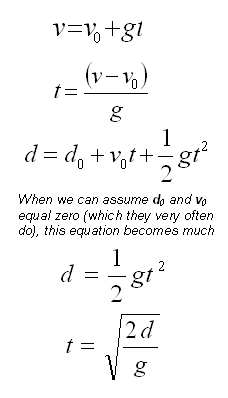

Freefall formula free#
Speed skydivers compete to achieve the highest terminal velocity during a free fall. The height most skydivers jump from is 4.2 km or 2.6 miles (14 000 feet).Įssentially, after terminal velocity has been reached, the time the object continues falling for does not matter, as the air resistance and buoyancy will are going to prevent further acceleration. When in this position, the terminal velocity jumps to 320 km/h, 200 mph, or 90 m/s. For example, if the skydiver pulls their limbs, they take the freeflying position. Higher speeds can be achieved during a skydive, by changing the skydiving position, which lowers the air resistance. It will take about 15 seconds to achieve 99% of the terminal velocity. This is in a belly-to-earth skydiving position. It was calculated that the terminal velocity of a skydiver during a free fall is about 195 km/h, 120 mph or 54 m/s. For more about acceleration, check out our Acceleration Calculator! When their sum equals the downward force of gravity ( F G), the object will stop accelerating. The restraining forces are the drag force, or air resistance ( F d) and buoyancy. The acceleration is 0 because of the restraining forces of the fluid it’s falling through. In other words, an object has reached terminal velocity if its speed is constant, or if the gravitational acceleration is 0. This can be in any fluid, not just air, although air is the most common example. Terminal velocity is the maximum velocity an object can reach during a free fall.

But even a heavy ball wouldn’t keep accelerating until it hit the ground, because eventually it would reach terminal velocity. This is why, when you drop a piece of paper, it just gets carried by the wind, but when you drop a ball, it falls straight to the ground. In reality, the mass of the object is very important.

As we said, in a vacuum, all objects have equal acceleration during a free fall. When not in a vacuum, however, we have to account for the force of drag as well. Skydiving in tandem, first seconds of free fall Free fall speedĪn object during a free fall in a vacuum, gains speed (accelerates), at a rate of 9.81 m/s 2 or 32.1850394 ft/s 2. This happens when they reach terminal velocity. Instead of this, skydivers have a feeling of their weight being supported on a cushion of air. However, in these cases, there is no sense of weightlessness. For example, falling through an atmosphere with a deployed parachute is considered a free fall. Generally, we use the term “free fall” more loosely. A feeling of weightlessness will also occur when there is no normal force between the object and it’s surrounding objects. This will happen if the object is far from any sources of gravity. If the gravitational force is also weak, there will be a sense of weightlessness. This is possible because of the absence of all other forces. In a gravitational field that is almost uniform, gravitation acts on each part of an object equally. However, its orbital speed keeps it very far from the Earth’s surface. As a result, the Moon is technically in free fall around the Earth. Despite the name, an object doesn’t necessarily have to be falling to be in a free fall. A free fall is any motion where the only force acting upon an object is gravity.


 0 kommentar(er)
0 kommentar(er)
